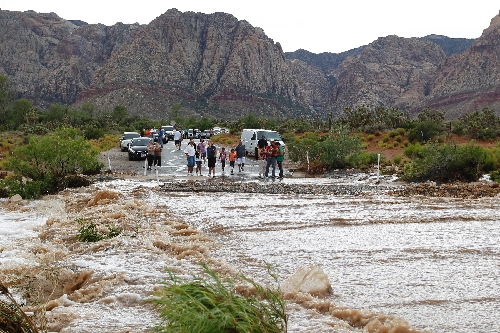Flooding an underestimated threat in Las Vegas Valley

Traveling up to 30 mph, the only thing more dangerous than the rapidly rising waters of a storm are misconceptions of flash flooding.
“People think because it’s a desert, there isn’t flooding,” said Betty Hollister, a spokeswoman for the Regional Flood Control District. “Even though flash flood season is July through September, floods can happen any time of the year without warning.”
In the past 50 years, the Regional Flood Control District has counted at least 36 deaths related to flash floods
“More deaths occur in floods than any other weather-related disaster,” Hollister said.
Even though the district has built 85 basins to enable 560 miles of drainage in the valley, it is up to people to remain safe during a flood.
Hollister said that first off, people need to know there is a difference between a flood warning and a flood watch.
“A flood watch means conditions are good and there might be a flood,” Hollister said. “A flood warning is when a flash flood is happening. It might not be in your area, but it is happening somewhere.”
Only the National Weather Service can declare a watch or a warning.
Just because the storm might be isolated in one part of the valley doesn’t mean it can’t affect other areas.
“The valley is like a bowl tipped on its side,” Hollister said.
Hollister said when it rains in the west or north, it drains toward Lake Mead.
Another misconception is when people try to cross flood waters in their cars.
“People think that they might be safer in a bigger vehicle,” Hollister said.
But a bigger vehicle might be more prone to float away because the tires have more air in them, causing greater buoyancy.
“The majority of flood-related deaths are caused by people attempting to drive through moving water,” Hollister said.
If a car stalls, it is safer to stay with the vehicle.
“Swift-moving water only inches deep can sweep you off your feet and result in drowning,” Hollister said.
As dangerous as people trying to drive through flood waters sounds, it is not the most far-fetched action people have taken during storms.
“We saw two boys on boogie boards during a storm,” Hollister said.
She also said there was a family seen in a kayak traveling down a basin.
“It is not only unhealthy,” Hollister said, “but it is incredibly dangerous.”
Hollister’s advice is simple: Wait out the storm.
“Be patient, because it will pass,” Hollister said. “Pull in a parking lot or get to higher ground. Grab a coffee or read the paper. It is not worth risking your life to get somewhere, because you may never make it.”
Even if people are prepared to wait out a flood, some aren’t equipped to deal with the aftermath of water damage.
Hollister suggests that people consider flood insurance.
“You can get some policies for $250 a year,” Hollister said. “Not very much for the peace of mind you get.”
Donna Fisher-Brown, a public affairs specialist with the insurance agency State Farm, said flood insurance rarely crosses people’s minds.
“Floods are the most common natural disaster in the U.S.,” Fisher-Brown said. “But many people don’t purchase flood insurance because they think it’s too expensive, they don’t need it or the government will take care of them (in the aftermath).”
Fisher-Brown said federal disaster assistance is available only if the president declares a disaster. Flood insurance is usually a separate policy from a standard homeowners insurance policy and costs about $400 on average.
“Flood insurance guidelines require a 30-day waiting period before new policies can be activated,” Fisher-Brown said. “It’s not something you can obtain on short notice. It’s a good idea to review what you have with your agent.”
For more information on floods, visit regionalflood.org.
Contact Henderson and Anthem View reporter Michael Lyle at mlyle@viewnews.com or 387-5201.
Get equipped for emergenciesBeing prepared for any emergency involves careful planning and education.
Residents should be sure that each family member is prepared to deal with emergencies by learning emergency services phone numbers, family member information and by developing a plan.
Children should know how to contact parents at work and which neighbors they should turn to in case of an emergency.
Home disaster supply kit
One part of planning is creating a home disaster supply kit for family members. It should include:
A three- to five-day supply of water, with 1 gallon per person, per day.
Nonperishable food that does not require cooking and a nonelectric can opener.
First-aid kit, medicine, a battery-operated radio, a flashlight, extra batteries, candles and lighters.
Items such as toilet paper and trash bags and an extra set of the keys you normally carry.
Change of clothes, rain gear, sturdy shoes, blankets or a sleeping bag.
Special items for infants, seniors and disabled family members, if needed, and a list of family physicians and emergency contacts.
Credit cards, cash and a cellphone and charger.
Copies of personal documents, including proof of address, deed/lease to home, passports, birth certificates, insurance policies and maps.
Prepare supplies for your pets
Pack essentials for each pet. An emergency pet kit should contain:
The pet’s normal food (with a can opener, if needed) and plenty of water.
Food and water bowls, blankets and towels.
Favorite toys.
Plastic bags to pick up excrement.
A leash and a collar with an ID tag.
A rabies vaccination tag.
Photocopy of shot record.
Veterinarian’s name, address and phone number.
A pet first-aid kit and any medications the pet may need.
A crate.
Sources: Centers for Disease Control, Southern Nevada Red Cross, Southern Nevada Health District, the American Kennel Club.












